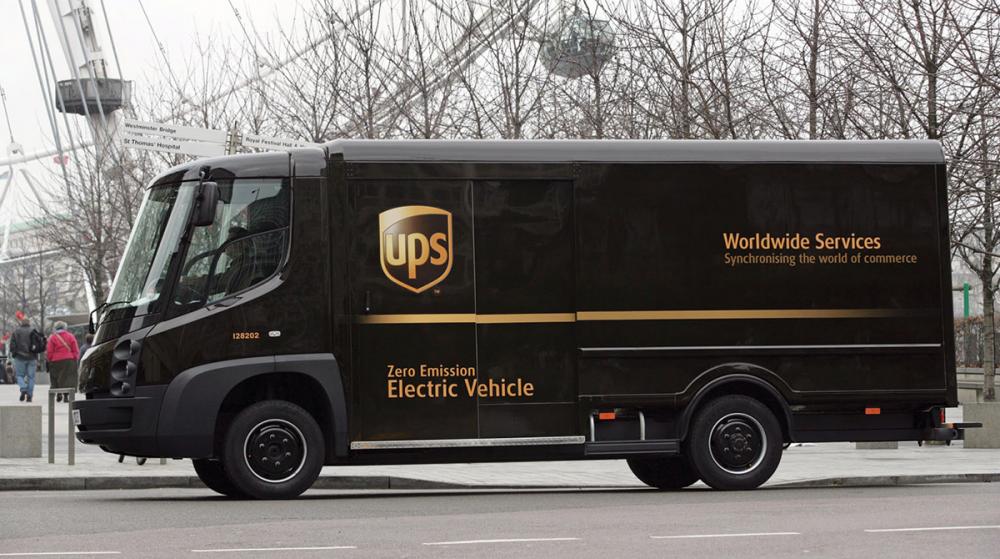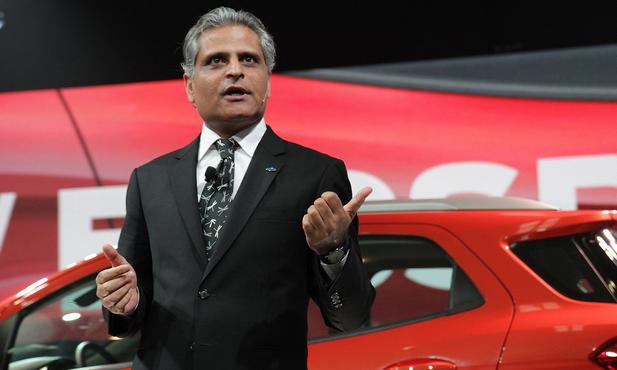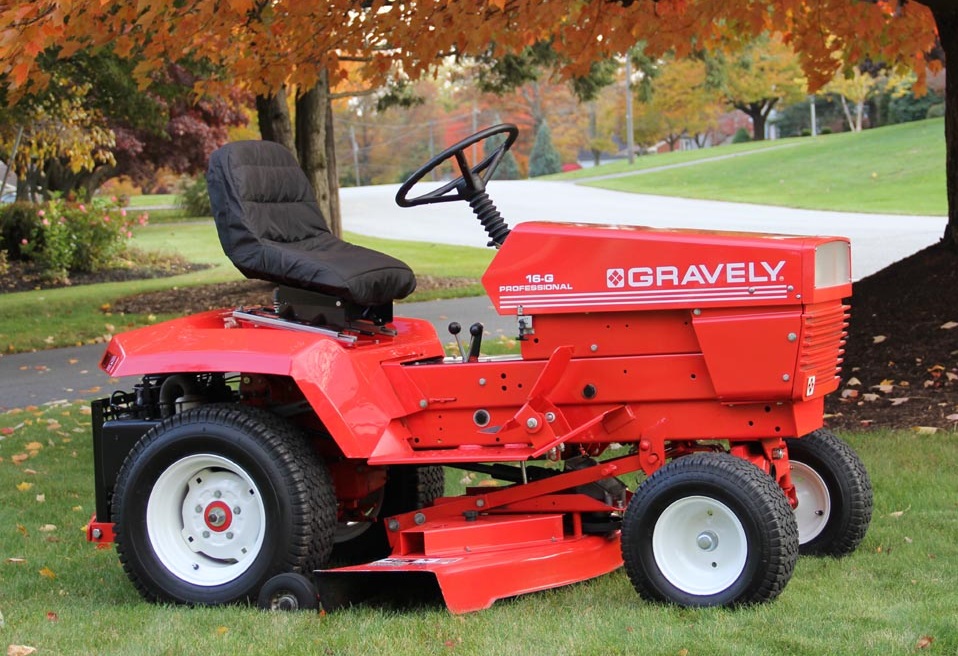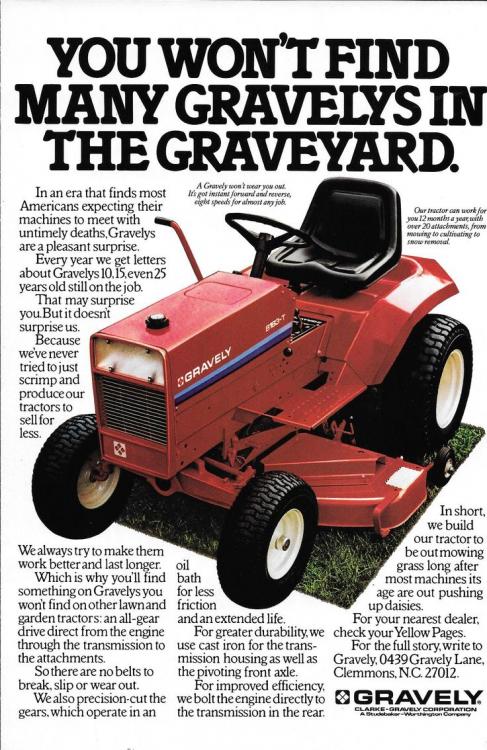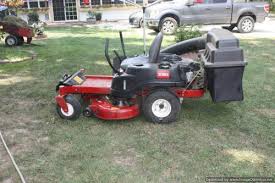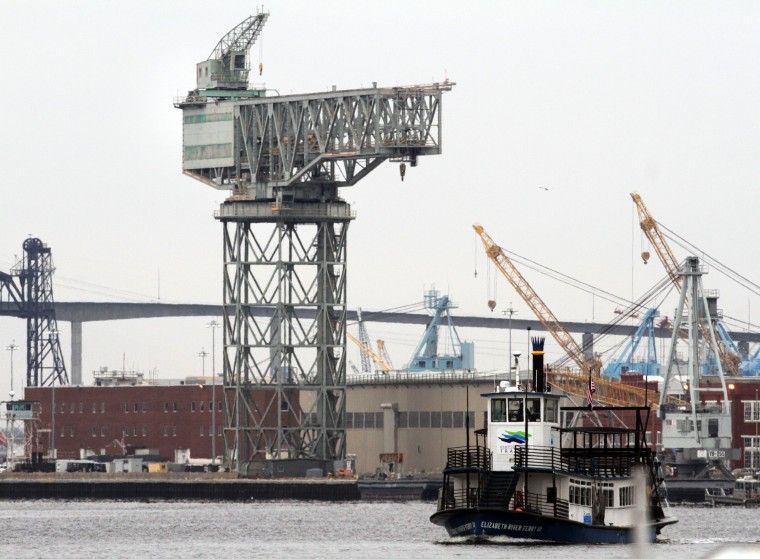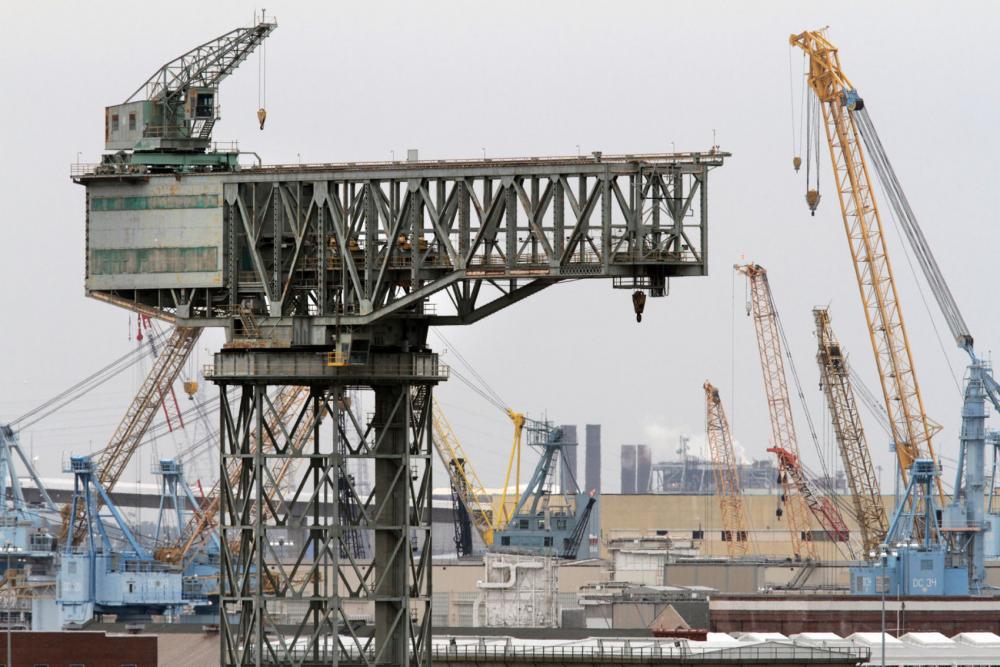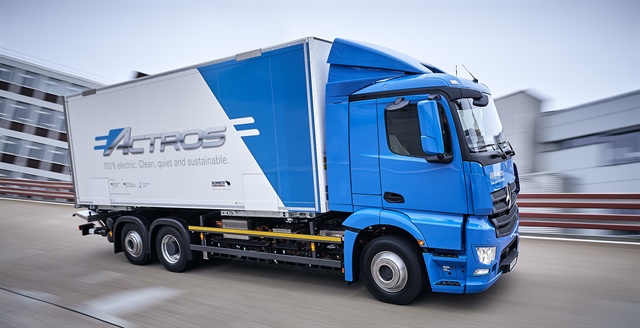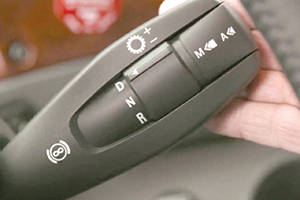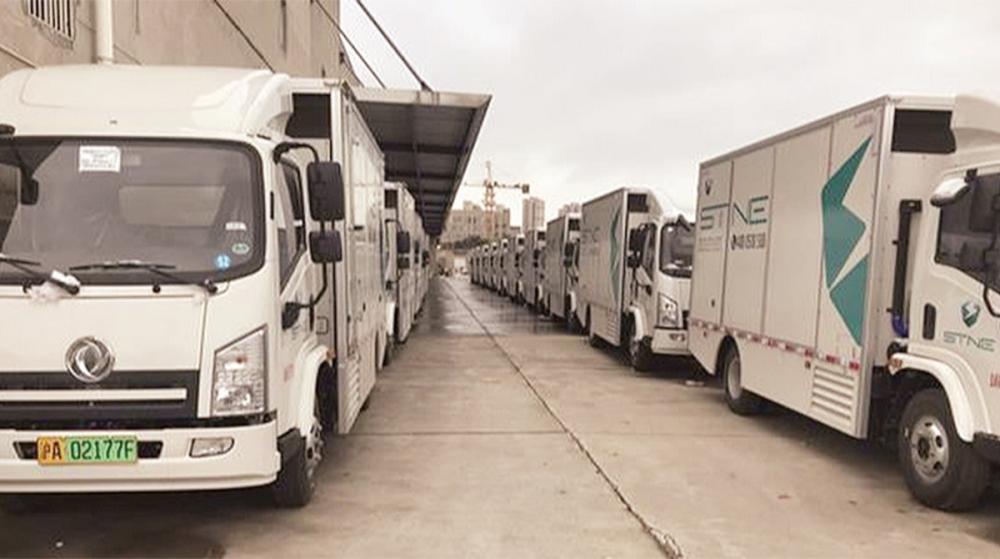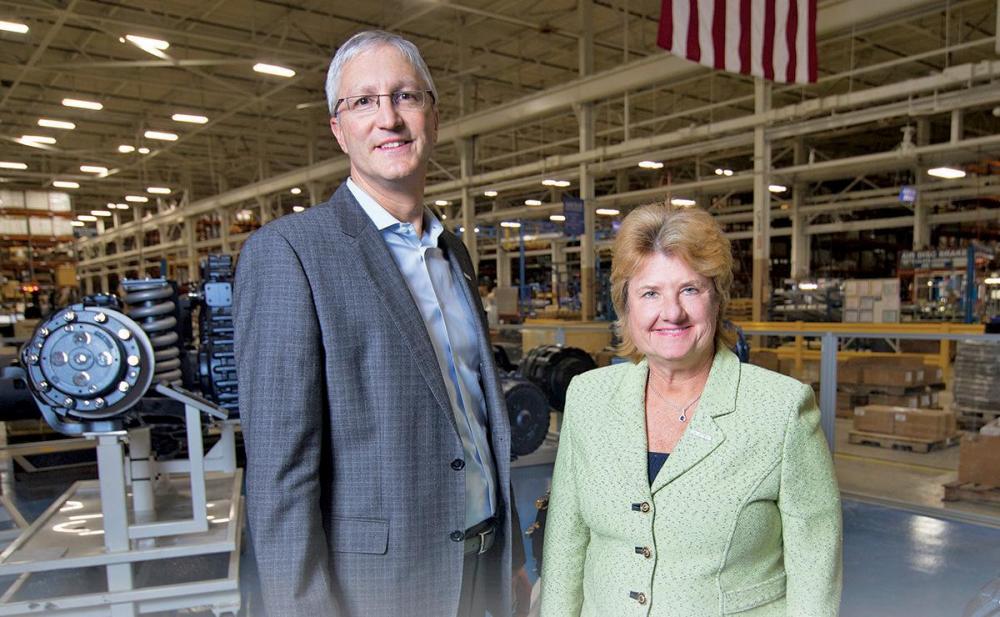
kscarbel2
Moderator-
Posts
18,893 -
Joined
-
Days Won
114
Content Type
Profiles
Forums
Gallery
Events
Blogs
BMT Wiki
Collections
Store
Everything posted by kscarbel2
-
What suspension is this?
kscarbel2 replied to seyser's topic in Antique and Classic Mack Trucks General Discussion
Not a clear picture, but could be a ST34 or ST38 Mack parabolic taper-leaf. -
Given it's a new 2017 truck, this is a warranty matter for a Mack brand dealer to resolve. If no Mack brand dealer can address it to your satisfaction, I suggest you contact Mack brand customer satisfaction at +1 (866) 298-6586. Get the customer after-sales support from the manufacturer that you paid for in purchasing a new truck.
-
Communist Party-backed Geely wants major Daimler stake
kscarbel2 replied to kscarbel2's topic in Trucking News
Communist Party-backed Geely buys $9 billion stake in Daimler Reuters, Bloomberg & Automotive News / February 23, 2018 Li Shufu, the chairman and main owner of Chinese carmaker Geely, has amassed a stake of 9.69 percent in Daimler AG, the German company said in a regulatory filing Friday. The stake, worth nearly $9 billion at the current market price for Daimler shares, makes Li the biggest single shareholder in the maker of Mercedes Benz cars, trucks and vans. Sources told Reuters this month that Geely was buying Daimler shares as it seeks an alliance in electric vehicle technology -- a response to Chinese requirements for more clean cars to be put on the road to cut pollution. A Daimler spokesman called the stake purchase a private investment by Li. "We are delighted, with Li Shufu, to have won over another long-term investor who is convinced of Daimler's innovative prowess, strategy and future potential," the spokesman said in response to a request for comment. "Daimler knows and respects Li Shufu as a Chinese entrepreneur of particular competence and forward thinking." Geely has been building up a stake of just under 10 percent through purchases of Daimler’s shares in the stock market in recent weeks. Zhejiang Geely owns Volvo and last year acquired a 49.9 percent stake in Malaysian automaker Proton. In addition, last December Geely spent $3.9 billion to become the biggest shareholder of Volvo AB, which is the world's second-largest truck maker. Last year Geely also won control of British sports car maker Lotus while in 2013 it purchased Manganese Bronze Holdings, rescuing the maker of London's iconic black cabs after it entered administration. Geely also plans to introduce to Europe its new brand Lynk & CO, which started sales in its home country last year. Following the potential deal, Zhejiang Geely would surpass Kuwait Investment Authority, as Daimler's top shareholder. Kuwait's sovereign wealth fund owned about 6.8 percent of Daimler's shares as Sept. 30, according to Thomson Reuters data. -
UPS and Workhorse to Collaborate on Electric Delivery Vehicles Heavy Duty Trucking (HDT) / February 22, 2018 UPS has announced plans to deploy 50 plug-in electric delivery trucks designed from the ground up as part of a collaboration with Workhorse Group. The two companies aim to produce electric delivery trucks that are comparable in acquisition cost to conventionally fueled trucks without any subsidies. The trucks are expected to have a range of around 100 miles per charge and provide a nearly 400% fuel efficiency improvement over conventional trucks. The Class 5 zero-emission trucks will feature a cab-forward design to optimize the driver compartment and cargo area, increase efficiency, and reduce vehicle weight. “Electric vehicle technology is rapidly improving with battery, charging and smart grid advances that allow us to specify our delivery vehicles to eliminate emissions, noise and dependence on diesel and gasoline,” said Carlton Rose, president, global fleet maintenance and engineering for UPS. “With our scale and real-world duty cycles, these new electric trucks will be a quantum leap forward for the purpose-built UPS delivery fleet. The all electric trucks will deliver by day and re-charge overnight.” The trucks will join UPS’s Rolling Lab, the company’s fleet of more than 9,000 alternative fuel and advanced technology vehicles. UPS will test the vehicles primarily on urban routes across the country, including in Atlanta, Dallas, and Los Angeles. Following real-world test deployments, UPS and Workhorse will fine-tune the design in time to deploy a larger fleet in 2019. Since most of the maintenance costs of a vehicle are associated with the engine and related components, UPS expects the operating cost of the new plug-in electric vehicle to be less than a similarly equipped diesel or gasoline vehicle. UPS’s goal is to make the new electric vehicles a standard selection, where appropriate, in its fleet of the future. UPS has more than 300 electric vehicles deployed in Europe and the U.S., and nearly 700 hybrid electric vehicles. The company recently ordered 125 new fully electric Semi tractors to be built by Tesla in 2019, the largest pre-order to date. Last year, UPS also announced it will become the first commercial customer in the U.S. to start using three medium-duty electric trucks from Daimler Trucks' Fuso brand, called the eCanter. UPS has an internal goal that one out of every four new vehicles purchased by 2020 will be an alternative fuel or advanced technology vehicle. The company has also pledged to obtain 25% of the electricity it consumes from renewable energy sources by 2025 and replace 40% of all ground fuel with sources other than conventional gasoline and diesel.
-
UPS to Add Zero-Emissions Delivery Trucks Transport Topics / February 22, 2018 UPS Inc. plans to deploy 50 plug-in electric delivery trucks that will be comparable in acquisition cost to conventional-fueled trucks without any subsidies — an industry first that is breaking a key barrier to large-scale fleet adoption. The company is collaborating with Workhorse Group Inc. to design the Class 5 vehicles from the ground up, with zero tailpipe emissions. UPS ranks No. 1 on the Transport Topics list of the largest for-hire carriers in North America. “With our scale and real-world duty cycles, these new electric trucks will be a quantum leap forward for the purpose-built UPS delivery fleet,” Carlton Rose, president of global fleet maintenance and engineering for UPS, said in a statement. Workhorse claims these vehicles provide nearly 400% fuel efficiency improvement as well as optimum energy efficiency, vehicle performance and a better driver experience. Each truck will have a range of approximately 100 miles between charges, according to UPS. Following test deployments, UPS and Workhorse will fine-tune the cab-forward design to deploy a larger fleet in 2019 and beyond. .
-
Jason Cannon, Commercial Carrier Journal (CCJ) / February 22, 2018 UPS says it will deploy 50 plug-in electric delivery trucks and will collaborate with vehicle-maker Workhorse Group to design the vehicles from scratch. Following real-world test deployments on urban routes across the country, including Atlanta, Dallas and Los Angeles, UPS and Workhorse expect to fine-tune the design in time to deploy a larger fleet next year. UPS President of Global Fleet Maintenance and Engineering Carlton Rose says he expects the electric vehicles to be competitively priced with conventional-fueled trucks without subsidies. “With our scale and real-world duty cycles, these new electric trucks will be a quantum leap forward for the purpose-built UPS delivery fleet,” he says, adding the all-electric trucks will deliver by day and re-charge overnight. Workhorse claims the Class 5 vehicles will provide a nearly 400 percent fuel efficiency improvement and each will feature a range of approximately 100 miles between charges. “This innovation is the result of Workhorse working closely with UPS over the last four years refining our electric vehicles with hard fought lessons from millions of road miles and thousands of packages delivered,” Workhorse Group CEO Steve Burns says. “Our goal is to make it easy for UPS and others to go electric by removing prior roadblocks to large scale acceptance such as cost.” The new trucks will join the UPS’s “Rolling Lab” fleet of more than 9,000 alternative fuel and advanced technology vehicles. UPS has more than 300 electric vehicles deployed in Europe and the U.S., and nearly 700 hybrid electric vehicles. The company in December ordered 125 new fully-electric Semi tractors to be built by Tesla in 2019, the largest pre-order to date. Last September, UPS announced it will become the first commercial customer in the U.S. to start using three Fuso eCanter medium-duty electric trucks. UPS says its goal is to make the new electric vehicles a standard selection, where appropriate, in its fleet of the future. UPS has approximately 35,000 diesel or gasoline trucks in its fleet that are comparable in size and are used in routes with duty cycles, or daily miles traveled similar to the new electric vehicles.
-
Ford picks Kumar Galhotra to replace Raj Nair as North America chief Michael Martinez, Automotive News / February 22, 2018 DETROIT -- Ford Motor Co. on Thursday tapped Kumar Galhotra, a company veteran who steered the Lincoln luxury brand back to respectability, to replace Raj Nair, who was ousted Wednesday after an internal investigation uncovered "inappropriate behavior," as its president of North America. Galhotra, 52, will take over Nair's duties in North America on March 1. He previously was group vice president, Lincoln and Ford's chief marketing officer. Galhotra had added chief marketing officer to his duties Nov. 1 last year. "Kumar is an incredibly talented executive with a special feel for product and brand. He is also a seasoned leader who knows how to drive a business transformation," Jim Farley, Ford's president of global markets, said in a statement. "Kumar is the right person to lead our North American business to new levels of operational fitness, product and brand excellence, and profitability." Joy Falotico will take over Galhotra's duties as group vice president of Lincoln and chief marketing officer, effective March 1. Falotico, 50, previously was CEO of Ford Credit. She will continue to serve as its chairman. "Joy has been a driving force behind not only Ford Credit's consistently strong financial performance but also its business model innovation and transition to a digital customer platform," Farley said. "She brings marketing experience and a deep customer focus as Ford enters a very busy new product launch period to drive growth in revenue and profitability." Additional appointments: David McClelland will succeed Falotico as CEO of Ford Credit. McClelland, 48, was most recently executive vice president, marketing and Asia Pacific. Stuart Rowley was named COO of North America, and will report to Galhotra. Rowley, 50, was previously vice president of strategy. He will be responsible "for driving the redesign of the North American business to improve its overall fitness," Ford said. John Lawler will succeed Rowley as vice president of strategy. Lawler, 51, will report to CFO Bob Shanks. He was most recently Ford's corporate controller. Cathy O'Callaghan, 49, will succeed Lawler as Ford's corporate controller. She most recently was CFO of Ford South America.
-
John Deere Introduces New Easy Change 30-Second Oil Change System
kscarbel2 replied to kscarbel2's topic in Odds and Ends
There are two categories today, both lawn and garden tractors, and riding lawn mowers. For example, the John Deere 100 Series are riding lawn mowers, You can fit a plow or snow blower, but that's about it. The Deere dealer exclusive 300, 500 and 700 Series "Select" models are full range lawn and garden tractors with heavier frames and a wide range of implements. http://www.deere.com/en_US/docs/html/brochures/publication.html?id=a56dff2b#1 The rear-engined Gravely tractors were a serious machine. . -
John Deere Introduces New Easy Change 30-Second Oil Change System
kscarbel2 replied to kscarbel2's topic in Odds and Ends
Your 149 Cub Cadet was, I feel, the best generation of them all. The chrome hydrostatic control lever stood out. -
John Deere Introduces New Easy Change 30-Second Oil Change System
kscarbel2 replied to kscarbel2's topic in Odds and Ends
Zero turns are great, particularly the short "stand on" commercial models (e.g. Ferris, Wright). However, if you bag, the issue with models like the Toro Timecutter zero turn is the long overall length with the rear-mounted bagger attachment at the rear. You lose the maneuverability potential of zero turns in tight spaces because of the long rear footprint swinging around behind you. . -
John Deere Introduces New Easy Change 30-Second Oil Change System
kscarbel2 replied to kscarbel2's topic in Odds and Ends
The Deere 100 Series are built in Tennessee. They are sold by Lowes, Home Depot AND Deere dealers. If you purchase at HD, it is prepped and delivered by your local Deere dealer (not sure about Lowes units). You can bypass Lowes and HD, and purchase at the Deere dealer directly for the same Lowes and HD price. I do prefer the Kawasaki engines on the Select Models sold at dealers, but a 100 series is half the price of an X300, and will suffice for most people if they only plan to mow. $40 is pricey for that “Easy Change” filter every 50 hours, given it's not synthetic oil. I dislike the Briggs engines on the 100 Series but again, for most people, they will meet expectations. . . -
John Deere Introduces New Easy Change 30-Second Oil Change System
kscarbel2 replied to kscarbel2's topic in Odds and Ends
. -
John Deere Introduces New Easy Change 30-Second Oil Change System
kscarbel2 replied to kscarbel2's topic in Odds and Ends
John Deere The John Deere Easy Change 30-second oil change system makes changing the engine oil easy, quick, and clean. Changing the oil is as easy as twisting on a new oil-filled filter. Oil does not need to be drained from the engine. The John Deere Easy Change filter is an additional engine oil reservoir. Changing the filter removes the captured contaminants and replaces about 0.8 qt (0.76 L) of the engine oil. Compared to the 100 Series traditional oil filter, the Easy Change oil system uses a synthetic filter media material, has more filtering capacity, and has more oil flow capacity, — and the engine system has 40 percent more oil volume. Everyone who uses the John Deere Easy Change system saves time and avoids the mess of a traditional oil change. In the past, many 100 Series Lawn Tractor owners rarely or never got around to changing their engine oil. With John Deere Easy Change, even owners who previously would not consider changing the oil themselves can easily do it now. The Easy Change 30-second oil change system is a no-mess, no-fuss solution the competition cannot match. Installation instructions are in the Operator’s Manual and in the John Deere Easy Change service part box. Please recycle. Many local government recycling programs, authorized retailers, auto-service centers, and auto-parts stores will puncture and recycle used oil filters -
OEM Off-Highway / February 14, 2018 John Deere's Easy Change system allows owners to change oil by simply twisting on a new cartridge that contains both the oil and the filter with no engine oil drainage needed. John Deere launches the Easy Change 30-Second Oil Change System for quick and easy oil changes on select lawn tractors. With the new system, owners can change oil by simply twisting on a new cartridge that contains both the oil and the filter – no engine oil drainage needed. This revolutionary technology makes changing the engine oil easy, quick, and clean. Changing the [$40] filter removes the captured contaminants and replaces about 0.8 qt (0.76 L) of the engine oil. This integrated system is exclusive to John Deere and reduces the skill and effort traditionally required for oil changes – no fuss, no mess. There is no draining required, and it takes one quarter turn to remove the old cartridge and another quarter turn to install a new cartridge. This makes is easy for nearly anyone to change the oil in their lawn tractor, empowering more owners to take tractor maintenance into their own hands. “Our main priority is to provide an easy and hassle-free experience for owners to maintain their lawn tractors,” says Kirk Eisenbeis, Product Marketing Manager for John Deere. “The ability to change oil easily, quickly, and without a mess is really appealing to people who don’t have traditional oil change experience.” The John Deere Easy Change 30-Second Oil Change system is available on the following 2018 models of 100 Series Lawn Tractors: E120, E130, E150, E160, E170 and E180. . .
-
Daimler Testing Heavy-Duty Electric Actros Truck
kscarbel2 replied to kscarbel2's topic in Trucking News
-
That big crane? Navy considers taking it down The Virginian Pilot / January 27, 2013 It's a Hampton Roads icon, a part of the region's landscape for more than 70 years, instantly recognizable. And it might be coming down. The Navy is weighing what to do with "Hammerhead Crane 110," which has towered over Norfolk Naval Shipyard in Portsmouth since 1940, where it played a big - very big - part of the yard's World War II effort. A study evaluating the crane's structural soundness is under way and expected to continue through April. One option: Tear it down. "A final decision might not be made for several months, potentially up to a year," said Michael Brayshaw, a shipyard spokesman. Though few may know it by name, its size makes it hard to miss. The hammerhead, as it's generally known, looks like a bridge from an old Erector set. "Not only is it the shipyard's largest crane, but at one point it was the largest crane of its type on the East Coast," Brayshaw said. Designed and built by Hyel-Patterson Corp. of Pittsburgh, the crane cost $640,000, according to the shipyard. Its intended use: building and servicing battleship turrets. At 260 feet tall and weighing 5 million pounds, the crane could lift and rotate a 350-long-ton load full circle around its base alongside the Elizabeth River. Two trolleys on the main hoist system worked in tandem to lift and position loads. But the crane has been inactive since 2001, and there's concern that its deterioration could make it more of a danger than an asset. Its demolition wouldn't be unprecedented. A hammerhead like it was torn down at the Brooklyn Navy Yard in New York in the 1960s. Meredith Wisner, archivist at the yard, said that the men and women who worked at that yard during World War II took the demolition hard. They considered the crane a kind of guardian of the yard, embodying their collective spirit, she said. "It was a very recognizable structure on our property." Hampton Roads' own hammerhead has more than a few admirers, too. Portsmouth Sheriff Bill Watson was a crane operator at the shipyard in the mid-to-late 1980s, and he says he was among those certified to run the big crane. He remembers sitting at the controls in the windowed cab that hangs from the bottom of the crane's big boom. "It was very intimidating when you first got in," he said. "Most people thought we were crazy anyway; if you have an issue with height, that's one crane you don't want to be on." The crane sways about 4 feet in either direction if the wind's blowing, he said. "I was up there in a hurricane one time; I'll never forget that one." A Portsmouth waterfront without the hammerhead is hard to fathom, one current shipyard worker said Friday. "That's our logo," he said. ----------------------------------------------------------------------------------------- What's up with the iconic Hammerhead Crane in Portsmouth? Not a whole lot. The Virginian Pilot / March 3, 2017 So what’s up with the Hammerhead Crane? Not a whole lot. For 77 years, it has towered over Norfolk Naval Shipyard in Portsmouth, an icon of the region’s waterfront. A key player during the yard’s World War II effort, it was last used in 2001. Since then, it’s become a safety hazard for shipyard personnel working near it. For four years or so, the Navy has been weighing what to do with the 5 million-pound, 260-foot-tall structure. An environmental assessment, a prerequisite for any decision about the crane’s future, was due a year ago, but is ongoing, a spokesman said last week in an email: The shipyard “continues to work with a number of consulting parties regarding the long-term future of the Hammerhead Crane.” At a public information meeting in August 2015, the Navy said three options were on the table: dismantling the crane, possibly saving some parts for museums; repairing it and sprucing it up, preserving it for 20 years as a kind of monument; and doing nothing. At that time, the Navy favored the first option, which was then estimated to cost about $1.7 million. First up, though, was completion of the environmental assessment, which was projected to wrap up around March 2016, with a decision to follow. The process continues. “That’s where we are,” Mike Brayshaw, a shipyard spokesman, said in a phone interview last week. “We’re still continuing to meet with stakeholders.” .
-
Heavy Duty Trucking (HDT) / February 21, 2018 A battery-electric heavy-duty hauler fitted with the Mercedes-Benz three-point star may be on the market in just three years. Taking the next step toward rolling out a fully electric heavy-duty hauler, Germany’s Daimler Ag will soon be placing its Mercedes-Benz eActros emissions-free trucks with some customers so that they can test “their everyday feasibility and economic efficiency under real-life conditions.” According to Daimler, the electric truck “could go into” full production starting in 2021. Operating solely on battery power, the eActros offers a range of up to 200 km (124 miles) yet offers the “customary level of performance and payload,” the OEM stated in a Feb. 21 news release. The customer test fleet consists of 10 trucks in 2-axle and 3-axle variants, with GVWs of 18 or 25 metric tons. The field-testing will start in the next few weeks and will run until at least mid-2020. Its aim is to establish energy requirements for some specific applications as well as the economic efficiency of the electric trucks and to compare their environmental performance vs. diesel trucks. “Initially the [fleet testing] focus will be on inner-city goods transport and delivery services – the ranges required here are well within the scope of our Mercedes-Benz eActros,” said Stefan Buchner, Head of Mercedes-Benz Trucks. "We have developed a vehicle that has been configured from the outset for electric mobility,” he added. “Compared with our prototype, quite a few technical changes have been made: the power supply is now ensured by eleven [lithium-ion] battery packs in all – and wherever possible we have used already proven components that are ready, or very close to ready, for use in [full] series production.” The road testing will help drive “ongoing optimization measures” and the results will be published, “giving potential users the opportunity to optimize their route planning or to develop new business models for their logistics processes. Back in 2016, at the IAA Commercial Vehicles show in Hanover, Germany, Mercedes-Benz displayed what it called an “Urban eTruck” as a concept for a heavy-duty electric-powered “distribution truck” aimed at urban use. The OEM said feedback to its presentation was “positive across the board,” including from customers as well as the general public and politicians, noting that in Germany alone, some 150 “very serious inquiries were received.” Testing by Customers Seen as Key to Completing Development “We now want to work together with our customers to move swiftly forward with the development of our Mercedes-Benz eActros to the point where it becomes a viable proposition in tough everyday operations - both technically and commercially,” Martin Daum, the Daimler AG Board Member responsible for Daimler Trucks and Buses, said in a statement. “We are beginning this process by creating an ‘innovation fleet’ and will be supporting its testing in the day-to day logistics environment of our customers. This will enable us to establish just what remains to be done, in terms of technical matters, infrastructure and service, to make our Mercedes-Benz eActros competitive” as a full-production truck. Daimler noted that “a number of technical and, above all, business-related issues remain outstanding” in the development of the eActros. Key among these are the truck’s range and the cost of batteries as well as the infrastructure required for use by fleets. .
-
Heavy Duty Trucking (HDT) / February 20, 2018 Paccar Inc. is recalling approximately 1,938 2017-2018 Kenworth T680 and T880 trucks as well as Peterbilt 567 and 579 trucks equipped with an automated Eaton UltraShift Plus or Eaton Advantage transmission with a right-hand stalk shifter because the transmission gear display may display incorrectly. For example, the display can indicate Neutral when the driver set the shifter into Drive or Reverse, which results in the failure of the truck to move. A vehicle that does not move as expected can increase the risk of an accident. To rectify the problem, Paccar will notify owners and dealers will install a complimentary transmission software update. The recall is expected to begin on April 2. Truck owners can reach Kenworth customer service at (435) 828-5000 or Peterbilt customer service at (940) 591-4000. Paccar's reference number for the Kenworth recall is 18KWA; the manufacturer’s reference number for the Peterbilt recall is 118-A.
-
Transport Topics / February 21, 2018 An aging driver population and the addition of vocational-specific features are the top reasons fleet managers and industry executives cited for growth in two-pedal transmission use among vocational truck buyers. For both torque converter automatics and automated manual transmissions, executives cited drivability — that expansive term that has come to describe trucks that feel and handle like a car — as a big motivator helping to convert old die-hard, double-clutching gear shifters to these transmissions. Further, today’s electronically controlled automatic and automated transmissions are offering application-specific features that appeal to construction companies, road pavers, cement mixers and other vocations with very specific needs, in which operators traditionally have believed that the job could only be done well by an experienced driver manually slugging through the gears. Though they declined to provide specific numbers, every truck maker contacted said interest in automatics and automated manual transmissions, or AMTs, is growing among their vocational customers. “The rise of two-pedal systems, whether it be Allison automatics or automated mechanical systems … are really continuing to increase,” said David Hillman, vice president of vocational marketing with International Trucks. “There are fans of each style.” “Drivability” and reducing driver fatigue are among the bigger reasons for the change on the vocational side, said Alex Stuckey, heavy-duty product strategy manager for Eaton Cummins Automated Transmission Technologies, the joint venture of engine maker Cummins Inc. and transmission supplier Eaton Corp. “We’re seeing growth in the adoption rate; we continue to see that ratio escalate and we anticipate that to continue.” Freightliner’s vocational customers are spec’ing “a high percentage” of 114SD models with automatics or AMTs, said Kelly Gedert, director of product marketing for Freightliner and Detroit Components. The take rate for the larger 122SD model is lower but increasing. Twenty-five years ago, Hillman said, the heavy vocational trucks were handled by drivers who prided themselves on their ability to handle a manual transmission in all sorts of situations; “real truckers,”as they might call themselves. “While there is still a fan base like that, it’s diminishing over time,” Hillman said. “Some drivers are retiring and some, although they’d swear up and down they were a three-pedal guy, try [an automatic or AMT] and realize they don’t have to monkey around with the shifting. They can focus on the job at hand.” Automatics and AMTs level the playing field when it comes to drivers, said Chad Brown, vice president of Brown Transportation, an aggregate hauler based in Ardmore, Okla. The company used to run 13-speed manuals, but the 80-truck fleet has been switching to automateds, in this case Eaton UltraShifts, as the fleet replaces its older equipment with new Kenworth trucks. “Where one guy may go through a clutch at 200,000 miles, another will go a lot longer. With the [AMT] you don’t have to worry about that. The [AMT] never misses a shift. The fuel economy is consistent throughout the whole fleet. It just gives me much better control over the fleet,” Brown said. But what do drivers say? “Driver fatigue is considerably less,” said Pete Pawloski, owner and operator of the single-unit Precise Concrete Pumping, based in Traverse City, Mich. Pawloski used to run an 8-speed manual until his new truck, an Autocar Xpeditor with an Allison RDS. “Once you go to an automatic, you realize how many times you’re pressing that left foot pedal and double clutching,” Pawloski said. “Your right shoulder begins to feel a little better. Another perk is safety. When I had the manual, there were a couple of certain intersections I would avoid because by the time you shift into second, you’ve already lost all forward momentum.” But drivability has been a selling point for automatics and AMTs for years in linehaul and nonvocational applications. What’s new is that advancements in low-end gearing, onboard technology, data gathering and fuel-economy features are making these transmissions more attractive for pavers, contractors and other vocational users, suppliers said. Freightliner’s Gedert said more vocational transmissions are going out with power take-off mounting and crawler gears. Those transmission choices and shift schedules were maximized for startability, gradeability and requested cruise speed, among other specs. The 14-speed version of Volvo’s I-Shift with crawler gears can be spec’d for use in applications up to 220,000 pounds gross combination weight and operate as low as 0.6 mph, said John Felder, product marketing manager for vocational trucks at Volvo Trucks North America. “That makes it ideal for paving,” he said. “We’ve also added Paver Assist for the I-Shift on Volvo VHD dump trucks to help eliminate bumps and disturbances in the pavement-laying process that traditionally occur while shifting from neutral to drive.” “A full automatic can provide a very high level of torque at low vehicle speed,” said Adam Burck, vice president of brand management with GVW Group, parent company of vocational truck maker Autocar. “On a construction work site, you’re using a very heavy vehicle, often in a slippery, unstable situation. It’s very hard for most drivers to move 100,000 pounds in sand. You can quickly dig the vehicle into soft ground. Also, all sorts of wheel hops and slips can lead to severe damage to driveline components and axle shaft failures.” Autocar offers automatic Allison transmissions in all of its trucks. Eaton Cummins’ Stuckey also said automated transmissions can provide durability advantages. “There are more opportunities to abuse a manual product,” Stuckey said. “We’ve done a lot [with AMTs] to protect the driveline and prevent damage through software. We’ve been working with engine platforms to develop calibrations paired with an engine’s torque curve to optimize performance.” Eaton’s 10/11-speed UltraShift Plus VCS/VMS (construction/multipurpose series) transmission offers extended low and reverse gear ratios, providing “the lowest ground speed for curbing, creeping, spreading and paving,” according to the company. Dave Jackson, co-owner of Redbank Transport Inc., a regional construction-materials hauler based in Milford, Ohio, likes the opportunity to have automatic and manual modes available. His drivers can forgo shifting when on the road, but they also have the option of shifting to manual mode for better control once they hit the job site. “When you pull into the job site, I tell [drivers] to put it into manual. You take control of the tranny and do what you want to do on that job site. You don’t want the tranny to guess,” he said. Also, having the AMTs means Jackson doesn’t have to teach new drivers how to shift. “Most of my [pre-employment] test driving now is to see how he handles a truck,” Jackson said. The data-gathering capability of today’s electronically controlled transmissions gives fleet managers insights into the transmission’s health and the driver’s skills, additional features Jackson said he appreciated. “I can also do things as a company to control my drivers. I can have them all shift at certain rpm. [The transmissions] have performance modes and economy modes that I can change from one driver to the next. I can do all that tweaking in house. It’s amazing what all we can do now with this,” Jackson said. The good news for vocational truckers is that the electronic capabilities and operational features of these transmissions will continue to develop. “Improved sensors and actuators, along with integrated chip density with sophisticated system software allows fast control loops and opens the door for further expansion of features so that there’s an AMT rated for any Class 8 vocational truck application,” Volvo’s Felder said. Customers can expect to see greater use of remote diagnostics, advanced prognostics, predictive maintenance and over-the-air programming, among other features, as systems develop, Freightliner’s Gedert said. For some applications, weight will influence the spec’ing decision. A fully automatic transmission with its torque converter and cooler can weigh several hundred pounds more than an automated manual, depending on the configuration. The listed weight of the Allison 4700 RDS 7-speed automatic, for example, ranges from 1,087 pounds for the basic version to 1,224 pounds with the power take-off and retarder. The Eaton Fuller Advantage automated 10-speed weighs in at 850 pounds, while the UltraShift Plus VPS/VPM 10/11-speed AMT for the vocational market is listed at a maximum of 978 pounds. Of course, if weight really does matter, the 10-speed manual Eaton Advantage weighs 541 pounds, 309 pounds less than the AMT version. Given that vocational trucks represent a comparatively small size of the heavy-duty market — less than 6% of new Class 8 vehicle registrations in 2017, according to IHS Markit — it may be understandable that it has taken a while for two-pedal transmissions to make notable inroads into the sector. But if the current demographic trends continue, more vocational fleets and drivers are going to be demanding that car-like drivability that automatics and AMTs offer. .
-
Raj Nair leaves Ford over 'inappropriate behavior' Michael Martinez, Automotive News / February 21, 2018 DETROIT -- Raj Nair, president of Ford Motor Co. in North America, has left the automaker after he was accused of "inappropriate behavior," Ford said Wednesday. Ford, in a statement, said an internal investigation found that "certain behavior by Nair was inconsistent with the company's code of conduct." It did not divulge the nature of the complaint, which a spokesman said was submitted anonymously through a 24-hour company hotline. Ford said it had not previously received any such allegations against Nair. Nair had been placed on leave during the investigation, which was conducted within the past few weeks and involved a small number of incidents, Ford said. His departure is effective immediately, and a spokesman said his successor will be named within days. CEO Jim Hackett said Ford "made this decision after a thorough review and careful consideration. Ford is deeply committed to providing and nurturing a safe and respectful culture and we expect our leaders to fully uphold these values." In the statement, Nair, 53, said, "I sincerely regret that there have been instances where I have not exhibited leadership behaviors consistent with the principles that the company and I have always espoused. I continue to have the utmost faith in the people of Ford Motor Company and wish them continued success in the future." Reached by phone at his home earlier Wednesday afternoon, Nair declined to comment to Automotive News when asked about his employment status with Ford. CFRA Research analyst Efraim Levy cited Nair’s ouster in lowering his rating of Ford shares Wednesday to “hold” from “buy.” “While we believe the company has a deep enough management bench to replace Mr. Nair with little disruption,” Levy wrote, “the new leader will face the challenges of an industry that will see rapid change in the medium- and long-term, while sales volume contracts in the U.S. in 2018.” Before being named to his latest position in May 2017, Nair was Ford's head of product development and chief technical officer. He oversaw the launch of the 2016 GT supercar, aluminum-bodied F-150 and 50th-anniversary Mustang, among a plethora of other vehicles. Less than two weeks ago, Nair took delivery of the first GT produced for the 2018 model year. Nair's tenure as product boss wasn't without controversy. The automaker twice had to lower mileage claims for its C-Max crossover and reimburse owners when the vehicle didn't achieve the rating originally advertised. Nair started at Ford in 1987 as a body and assembly operations launch engineer and held various positions on more than 11 vehicle programs in 13 assembly plants, according to Ford's media website. He also worked on assignments in Europe, South America and Asia Pacific. Days before Jim Hackett was named CEO, Ford last year awarded Nair a $5 million retention bonus that would vest in May of 2020. .
-
Bloomberg / February 21, 2018 MUNICH -- Daimler AG cast doubt on Tesla Inc.'s plan to deliver electric heavy trucks next year, saying its more modest goal to start selling battery-powered big rigs by 2021 is more realistic. Daimler, best known for its luxury cars, is also the world's biggest truckmaker, giving Daimler the most to lose should Tesla boss Elon Musk succeed in producing a semi-truck with a 500-mile range for delivery starting in 2019. If that happened, Daimler would have miscalculated to an unimaginable degree, head of trucks Martin Daum suggested to reporters at an event Wednesday in Stuttgart. He announced plans to start rolling out Mercedes-Benz electric trucks for trials this year, followed by mass production as of 2021. The driving range is smaller than Musk is targeting. Current battery technology doesn't allow for faster timelines, Daum said. "If Tesla really delivers on this promise, we'll obviously buy two trucks -- one to take apart and one to test because if that happens, something has passed us by," Daum said. "But for now, the same laws of physics apply" in Germany and in California, where Tesla is based, he added. The Mercedes-Benz electric Actros, starting with 10 vehicles, will deliver loads on city distribution routes with a maximum range of 124 miles, Daimler said. German supermarket chain Edeka and parcel delivery service Hermes are among early testers who'll receive vehicles in the next few weeks for a trial lasting around two years. Daimler will spend $616 million this year and next on its effort for electric and connected trucks, it said. Aside from Tesla, other manufacturers like Volvo AB are working on new technology to propel commercial vehicles. High costs and limited longevity of batteries have so far put trucks behind development timelines for cars. The e-Actros as part of the pilot will feature two versions with total weights of 18 tons and 26 tons, Daimler said. They'll take three to 11 hours to charge. Broad demand will need time to take hold, Daimler said. "Trucks have to run for 1.5 million miles and then there's a used-truck buyer too after that," said Daum. "We don't know for sure how batteries for trucks will react after being in use for four to five years -- it's very complex."
-
Ballard Fuel Cells to Power Large Deployment of Chinese Trucks
kscarbel2 replied to kscarbel2's topic in Trucking News
Bob, if I was Ballard, I’d steer clear. But he’s still desperate to get airborne, and desperation can cause temporary blindness. -
Transport Topics / February 20, 2018 Ballard Power Systems Inc. announced the planned deployment of 500 licensed fuel-cell electric commercial trucks in Shanghai, purportedly the largest of its kind in the world. Each of the 500 trucks from Dongfeng Special Vehicle Co. is licensed, plated and powered by a 30-kilowatt fuel-cell engine that was designed and integrated by Shanghai Reinventing Fire Technology Co., featuring Ballard FCvelocity-9SSL proton exchange membrane fuel-cell stacks, according to the Vancouver, British Columbia-based company. Each box van truck measures 21 feet, can carry a load of 3.2 tons and has an expected range of more than 205 miles. The trucks will be operated by Shanghai Sinotran New Energy Automobile Operation Co., a newly established fuel-cell electric vehicle operator, and are expected to be used primarily for intra-city deliveries. “We are pleased to be collaborating with Re-Fire as we drive market adoption of fuel cell electric vehicles (or FCEVs) incorporating Ballard fuel cell technology. We believe this is the largest planned deployment of fuel cell-powered trucks anywhere in the world,” Ballard CEO Randy MacEwen said in a statement. Ballard noted China is forecast to account for 42% of global production of medium- and heavy-duty trucks in 2020, or about 1.1 million units, according to LMC Automotive. Ballard also supplied the fuel cell for Kenworth Truck Co.’s hydrogen-electric Class 8 bound for a field test at the ports of Los Angeles and Long Beach in March. The battery capacity for that truck is 100 kW-h. .
-
Wrightspeed partners with AxleTech on heavy-duty electric drive
kscarbel2 replied to kscarbel2's topic in Trucking News
Another reinvention for AxleTech Lindsay Chappell, Automotive News / February 19, 2018 Turnaround chief steers company into electricfication niche Three years ago, Mary Petrovich got a call from an executive at defense contractor General Dynamics asking if she would take over the struggling Detroit-area commercial vehicle supplier AxleTech International. Petrovich knew all about AxleTech because she had run the company and reinvented it. Twice. Petrovich had led the fast- growing company's sale to General Dynamics seven years earlier, in 2008. But in 2015, AxleTech was in trouble. "There was some hesitation," admits Petrovich, a Harvard MBA who once ran Dura Automotive's billion-dollar global driver control business. "Only because I wanted to make sure I had it in me to do this a third time." Her idea of turning a company around? "Seven days a week, 80 hours a week until you succeed," she says. "But I felt like it was my baby and I was responsible for it," she says. "I knew that, no matter how ugly it looked to other people, there were still possibilities to make it great. It took us three years to dig them out, but we've done it and we're ready to go. Again." Petrovich was on Automotive News' list of 100 Leading Women in the North America Auto Industry in 2000 when she was at Dura. Today, Petrovich, 55, is leading a team to take AxleTech into a new transportation role. AxleTech, a supplier of low-volume axles, brakes and aftermarket parts for heavy-duty commercial and defense vehicles, is positioning itself to supply electric drivetrains for vehicles other than cars. It is a vision — shared by an increasing number in the auto industry — that just as electrification is taking hold of passenger vehicles, it is also a viable strategy for commercial vehicles. That means electrified delivery trucks, Class 8 trucks, garbage trucks, utility vehicles, military vehicles, buses, construction vehicles, airport shuttles — anything that moves on wheels, other than cars. But even cars cause a twinkle in the eye of the hard-charging Detroit executive. "Since this business started 100 years ago, the focus has been on heavy trucks and off-road," she told Automotive News. "But to be honest, the work we're doing now in electric vehicles, in areas like motors — they touch both the truck world and the car world. Some of the innovations we're providing on the heavy truck side have not been implemented on the car side. "So I wouldn't see it as a stretch that little AxleTech could have technology that could creep over into passenger cars." "Little AxleTech," as she calls it — with 2017 sales of about $250 million — has been something of a Detroit stray cat for the past two decades. And apparently only Petrovich knows how to make it purr. AxleTech is the original industrial operation once known as Rockwell International. AxleTech still operates the century-old factory in Oshkosh, Wis., built by the industrialist Col. Willard Rockwell in 1919. But since the early 2000s, the company has had trouble being "owned." In 2002, Rockwell's descendant company, Meritor Automotive, determined that AxleTech didn't fit with its core operations and put it on the market. The unit was acquired by a private equity firm, and Mary Petrovich was recruited as its first CEO. "When we took over this business in 2002, most people thought it was going to die pretty quickly," she says. "It had everything going against it. We were very aggressive in getting out of that." Enter Carlyle But that ownership arrangement was short-lived, and in 2005 AxleTech was sold again to the Carlyle Group, a Washington asset-management firm with $178 billion in assets. Under Carlyle, Petrovich repositioned AxleTech again — this time to enter the robust market for military vehicles, supplying drivetrains to Mine Resistant Ambush Protected vehicles used in the wars in Iraq and Afghanistan. Under Carlyle, business surged, rising from about $200 million in 2005 to $500 million in 2008. Petrovich also stoked AxleTech's aftermarket business for the first time. In five years, Aftermarket Vice President Bill Gryzenia grew sales from $10 million a year to $200 million annually by 2010. In 2008, with the military market humming loudly, Carlyle sold AxleTech again — this time to General Dynamics. Petrovich and Gryzenia left in 2010 for other pursuits. But sales peaked in 2011 at about $560 million. In 2015, with defense contracts dwindling and General Dynamics no longer keen on operating a small niche business such as AxleTech, the call went out to Petrovich to take the company back off of its hands. Carlyle and Petrovich agreed. She would serve Carlyle as AxleTech's executive chairman and take an ownership stake. She rehired Gryzenia — who had become Dana Corp.'s vice president of aftermarket — to return as AxleTech's CEO. "We got another opportunity to use a clean sheet of paper," Gryzenia says. "We asked, 'How can we redefine this company? How can we put it back on a rapid growth path again?' "And three years in, we're doing it — through electric commercial vehicles." The auto industry's focus has been on electric passenger vehicles, he points out, while electrifying commercial trucks is an obvious play. Electrification offers truck owners and fleet operators a faster payback on investments, since fuel costs are a central part of commercial vehicle purchase equations. But AxleTech's management is far from alone in its enthusiasm for the idea. Tesla plans to develop an electric semitruck and startup contender Nikola proposes the same idea. Diesel engine maker Cummins late last month acquired the British battery systems business of Johnson Matthey to develop new battery materials to enter the commercial heavy-duty EV segment. Last week, Dana CEO James Kamsickas told analysts on the company's earnings call that Dana sees potential for an electrified commercial vehicle market. The company is marketing an e-axle to the electric bus segment. But Kamsickas said the technology reaches beyond buses. "There's not one end market that we're not in some form of conversation, product development, launch, you name it," he told the analysts. "That could be mining, construction, forklifts, glass material handling — every single one of them." Engineers Petrovich believes AxleTech has a head start because her team has been preparing for the market since returning to the helm three years ago. AxleTech has expanded its global manufacturing footprint, opening a plant in India and in China, and has increased its engineering head count by about 70 percent. Space in the U.S. company once used to produce component forgings is now used for engineering offices. According to Gryzenia, the company has filed for more patents in the past 12 months than in the previous 10 years. AxleTech's engineers have co-developed a drivetrain for an electric bus with zero-emission bus maker Proterra that is scheduled to go into production in the third or fourth quarter. Petrovich expects to double company revenue within 24 months. "That's the story — to be there on the commercial vehicle side of electrification," she says. "We're working with major programs across utility space — garbage trucks, military vehicles. In the next 2 to 15 years, everything is going electric."
BigMackTrucks.com
BigMackTrucks.com is a support forum for antique, classic and modern Mack Trucks! The forum is owned and maintained by Watt's Truck Center, Inc. an independent, full service Mack dealer. The forums are not affiliated with Mack Trucks, Inc.
Our Vendors and Advertisers
Thank you for your support!


